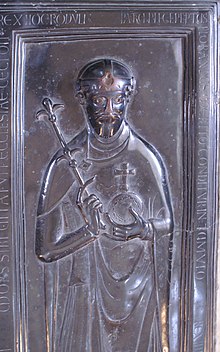
Albert I of Habsburg was a Duke of Austria and Styria from 1282 and King of Germany from 1298 until his assassination. He was the eldest son of King Rudolf I of Germany and his first wife Gertrude of Hohenberg. Sometimes referred to as 'Albert the One-eyed' because of a battle injury that left him with a hollow eye socket and a permanent snarl.

Boleslaus I, a member of the Přemyslid dynasty, was ruler of the Duchy of Bohemia from 935 to his death. He is notorious for the murder of his elder brother Wenceslaus, through which he became duke.

The Duchy of Bohemia, also later referred to in English as the Czech Duchy, was a monarchy and a principality of the Holy Roman Empire in Central Europe during the Early and High Middle Ages. It was formed around 870 by Czechs as part of the Great Moravian realm. Bohemia separated from disintegrating Great Moravia after Duke Spytihněv swore fealty to the East Frankish king Arnulf in 895.

Bretislav I, known as the "Bohemian Achilles", of the Přemyslid dynasty, was Duke of Bohemia from 1034 until his death.
Frederick I before 21 July was Duke of Swabia from 1079 to his death, the first ruler from the House of Hohenstaufen (Staufer).
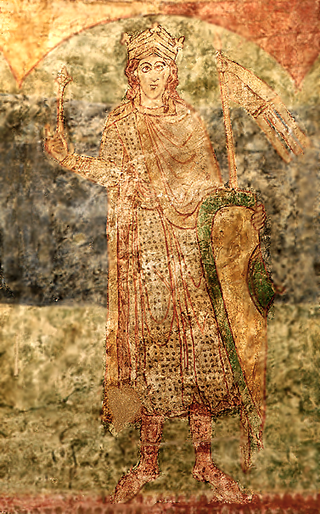
Vratislaus II, the son of Bretislaus I and Judith of Schweinfurt, was the first King of Bohemia as of 15 June 1085, his royal title granted as a lifetime honorific from Holy Roman Emperor Henry IV that did not establish a hereditary monarchy. Before his elevation to the royal dignity, Vratislaus had ruled Bohemia as duke since 1061.

Vladislaus I was Duke of Bohemia from 1109 to 1117 and from 1120 until his death.
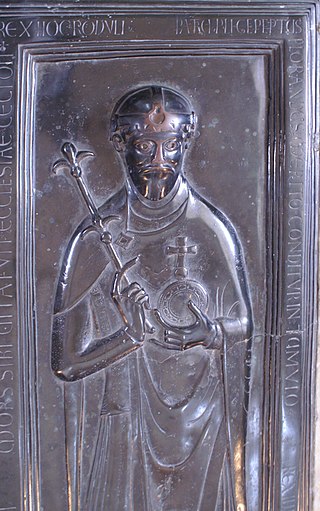
Rudolf of Rheinfelden was Duke of Swabia from 1057 to 1079. Initially a follower of his brother-in-law, the Salian emperor Henry IV, his election as German anti-king in 1077 marked the outbreak of the Great Saxon Revolt and the first phase of open conflict in the Investiture Controversy between Emperor and Papacy. After a series of armed conflicts, Rudolf succumbed to his injuries after his forces defeated Henry's in the Battle on the Elster.
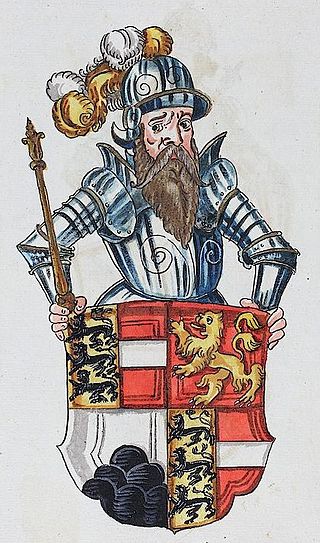
Berthold II, Duke of Carinthia, also known as Berthold I of Zähringen, was a progenitor of the Swabian House of Zähringen. From 1061 until 1077, he was the Duke of Carinthia and Margrave of Verona.

The Margravate of Meissen was a medieval principality in the area of the modern German state of Saxony. It originally was a frontier march of the Holy Roman Empire, created out of the vast Marca Geronis in 965. Under the rule of the Wettin dynasty, the margravate finally merged with the former Duchy of Saxe-Wittenberg into the Saxon Electorate by 1423.
Egbert II was Count of Brunswick and Margrave of Meissen. He was the eldest son of the Margrave Egbert I of the Brunonen family.
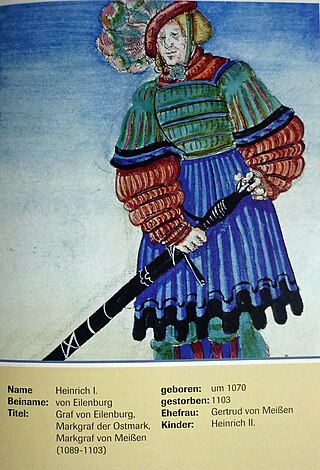
Henry I, nicknamed the Old, a member of the House of Wettin, was Count of Eilenburg as well as Margrave of the Saxon Eastern March from 1081 and Margrave of Meissen from 1089 until his death.

The Margraviate of the Nordgau or Bavarian Nordgau was a medieval administrative unit (Gau) on the frontier of the German Duchy of Bavaria. It comprised the region north of the Danube and Regensburg (Ratisbon), roughly covered by the modern Upper Palatinate stretching up to the river Main and, especially after 1061, into the Egerland on the border with Bohemia.

Wiprechtof Groitzsch was the Margrave of Meissen and the Saxon Ostmark from 1123 until his death. He was born to a noble family of the Altmark, the son of Wiprecht of Balsamgau and Sigena of Leinungen. After his father's death in 1060, he was raised at the court of Lothair Udo II, Margrave of the Nordmark, in Stade.

The Saxon revolt was a civil war fought between 1077 and 1088, early in the history of the Holy Roman Empire. The revolt was led by a group of opportunistic German princes who elected as their figurehead the duke of Swabia, Rudolf of Rheinfeld, who became the anti-king. Rudolf was a two-way brother-in-law of the young Henry IV, Holy Roman Emperor, who had been crowned at the age of six and had taken the reins of power at age sixteen. The Great Revolt followed the Saxon Rebellion of 1073–75.

Battle on the Elster was the third and last battle between the Salian king Henry IV of Germany and anti-king Rudolf of Rheinfelden, fought on October 14, 1080 near Hohenmölsen on the White Elster river. Rudolf's forces were victorious; however, he was mortally wounded and succumbed to his injuries the next day.
Battle of Mellrichstadt was fought between Holy Roman Emperor Henry IV and the German anti-king Rudolf of Swabia on 7 August 1078 near Mellrichstadt.

Henry IV was Holy Roman Emperor from 1084 to 1105, King of Germany from 1054 to 1105, King of Italy and Burgundy from 1056 to 1105, and Duke of Bavaria from 1052 to 1054. He was the son of Henry III, Holy Roman Emperor—the second monarch of the Salian dynasty—and Agnes of Poitou. After his father's death on 5 October 1056, Henry was placed under his mother's guardianship. She made grants to German aristocrats to secure their support. Unlike her late husband, she could not control the election of the popes, thus the idea of the "liberty of the Church" strengthened during her rule. Taking advantage of her weakness, Archbishop Anno II of Cologne kidnapped Henry in April 1062. He administered Germany until Henry came of age in 1065.

The German–Polish War consisted of a series of struggles in 1003–1018, between the Ottonian king Henry II of Germany and the Polish Piast ruler Bolesław I the Brave. The locus of conflict was the control of Lusatia, Upper Lusatia, as well as Bohemia, Moravia and Slovakia. The fighting ended with the Peace of Bautzen in 1018, which left Lusatia and Upper Lusatia as a fief of Poland, and Bohemia became a duchy in the Holy Roman Empire.

The Saxon revolt refers to the struggle between the Salian dynasty ruling the Holy Roman Empire and the rebel Saxons during the reign of Henry IV. The conflict reached its climax in the period from summer 1073 until the end of 1075, in a rebellion that involved several clashes of arms.
